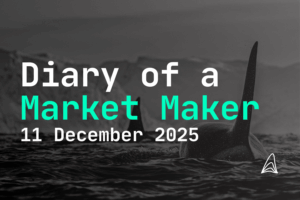
Distributed Ledger Tech: The Future of Secure Transactions
- Jakob Brezigar
- Last updated: 06.September 2024
- Reading time: 9 min
Remember when keeping track of your baseball card collection was a nightmare? Imagine if each card could validate itself, eliminating disputes with friends over who has the rarest card. That’s distributed ledger technology in a nutshell, bringing transparency and security to digital transactions. A distributed ledger platform can facilitate secure and transparent transactions, rewarding participants with cryptocurrency for contributing computational resources. Now, let’s talk crypto: creating tokens is like minting your own baseball cards, except they’re digital, unique, and powered by blockchain. Each token represents a piece of value or utility, securely recorded and easily traded. Dive in to explore the magic behind distributed ledger tech!

Table of Contents
What is distributed ledger technology (DLT)?
Distributed ledger technology (DLT) is a decentralized database spread across multiple nodes or computers. It records transactions securely and transparently using cryptographic techniques, ensuring that the data is tamper-evident and immutable.
How does DLT benefit crypto market makers like Orcabay?
DLT benefits crypto market makers by enhancing liquidity, transparency, and efficiency. It uses smart contracts to automate trade executions and settlements, reducing costs and increasing trust among participants.
What industries can benefit from DLT?
Industries such as banking, healthcare, real estate, and supply chain management can benefit from DLT. It offers improved security, transparency, and efficiency, making it ideal for various applications in these sectors.
Key Takeaways - Distributed Ledger Tech:
DLT enhances security and transparency in digital transactions by using cryptographic techniques and decentralized databases.
DLT enables real-time trade verification and transaction recording for crypto market makers like Orcabay, improving liquidity and reducing fraud.
Smart contracts in DLT automate trade executions and settlements, reducing operational costs and latency in the crypto market.
DLT applications span industries such as banking, healthcare, real estate, and supply chain management, offering diverse benefits.
Challenges for DLT include scalability, interoperability, and evolving regulatory frameworks, but ongoing innovations continue to address these issues.
The importance of interoperability between different distributed ledger systems is emphasized, with ongoing efforts to develop solutions for seamless data exchange and collaboration.
What Is Distributed Ledger Technology (DLT)?
Distributed ledger technology (DLT) is centered around an encoded and distributed database where records regarding transactions are stored. Unlike traditional databases, a distributed ledger is spread across various computers, nodes, institutions, or countries, accessible by multiple people around the globe. This decentralized approach ensures that the data remains secure and tamper-evident. DLT employs cryptographic algorithms to safeguard information, making unauthorized alterations nearly impossible. This robust security framework has positioned DLT as a cornerstone in modern digital transactions, providing an immutable database that supports a wide range of applications.
In What Ways Do the Crypto Market Makers Utilize the Distributed Ledger Tech?
Crypto market makers like Orcabay leverage distributed ledger technology to enhance liquidity, transparency, and efficiency in trading. By using DLT, we can record and verify transactions in real-time, ensuring a tamper-evident and immutable history of trades. This reduces the risk of fraud and enhances trust among participants. Additionally, the use of DLT allows for decentralised exchanges, where trades can be executed without the need for a central authority, providing greater flexibility and security in the crypto market.
Distributed Ledger Technology (DLT) is Centered Around Encoded Database
At its core, DLT leverages cryptographic techniques to encode transaction records, which are then distributed across a network of computers. This network is not confined to a single location but spans multiple nodes, enhancing the system’s resilience and security. This distributed database system is designed to prevent a single point of failure, which is a common vulnerability in centralized systems. With each node holding an identical copy of the ledger, the distributed ledger tech ensures that the data is consistently updated across the entire network, maintaining integrity and accuracy.

Distributed Ledger Database is Spread Across the World
The distributed nature of DLT means that there is no single point of failure. Each participant in the network holds a copy of the ledger, and changes to the ledger are only possible through consensus among participants. This ensures that the data is not only widely accessible but also highly secure. The multiple entities involved in maintaining the ledger enhance its robustness, making it more resilient to attacks and technical failures. This structure supports a decentralized network, which is crucial for maintaining data integrity in distributed ledger technologies.
Features Of DLT
DLT encompasses various features that make it a robust solution for secure transactions. These include the decentralized storage of data, the use of cryptographic keys and cryptographic signatures for access and ensuring data integrity, and consensus mechanisms for validating transactions without the need for a central authority. The use of multiple nodes ensures that the system is both scalable and flexible, capable of adapting to various applications from financial transactions to supply chain management. The cryptographic algorithms used in DLT provide a high level of security, making it a preferred choice for sectors that require stringent data protection measures.
History of Distributed Ledgers
Distributed computing is not new—businesses and governments have been using the concept for several decades. Advances in data science, computing, software, hardware, and other technologies have made ledgers much more capable.
The concept of distributed computing has been around for decades, with businesses and governments leveraging it to improve efficiency and resilience. Early forms of distributed ledgers were used in the 1990s for systems that required high levels of data integrity and security. The evolution of distributed ledger technology has been marked by significant advancements in data science, computing power, and software development. These technological improvements have transformed simple distributed systems into sophisticated, cryptographically secure platforms capable of supporting complex transactions and applications.
In recent years, advancements in data science, computing, software, and hardware have significantly enhanced the capabilities of distributed ledgers. Modern DLT systems can handle vast amounts of data with greater speed and security than ever before, making them suitable for a wide range of applications. The integration of cloud computing and advanced cryptographic algorithms has further bolstered the efficiency and security of these systems. As a result, distributed ledger technologies have become integral to industries ranging from finance to healthcare, providing a secure and reliable framework for digital transactions and data management.
How DLT Works
Decentralized and Distributed Architecture
DLTs allow information to be stored securely and accurately using cryptography. Each transaction is encrypted and linked to the previous one, creating a chain of records that is immutable and tamper-evident. Access to data on a distributed ledger is controlled through cryptographic keys and signatures. These keys ensure that only authorized parties can read or modify the data, maintaining the integrity and confidentiality of the information. The use of digital signatures in DLT systems further enhances the security of transaction records, ensuring that only legitimate changes are made to the ledger.

No Central Authority, Only Nodes
DLT eliminates the need for a central authority to validate transactions, using consensus mechanisms instead. Validators are chosen to validate transactions based on certain criteria, such as the number of tokens they hold and are willing to stake as collateral, reducing the need for computational power. Transactions are validated through consensus mechanisms, where multiple nodes agree on the validity of a transaction before it is recorded on the ledger. Each node in the network maintains a complete copy of the distributed ledger, ensuring redundancy and resilience. This distributed approach ensures that the system can continue to function even if some nodes go offline or are compromised. The decentralized system employed by DLT ensures that there is no central point of control, which enhances the overall security and robustness of the network.
Consensus Mechanisms for Validation
Consensus mechanisms play a critical role in ensuring the integrity and security of DLT by validating transactions and reaching consensus among a disparate user base. They ensure that all participants agree on the state of the ledger, preventing fraud and double-spending. Various consensus mechanisms are employed in DLT systems, including Proof of Work (PoW), Proof of Stake (PoS), and Directed Acyclic Graph (DAG). Each mechanism has its own advantages and is suited to different types of distributed ledgers. PoW, for example, involves solving complex mathematical problems to validate transactions, while PoS assigns validation rights based on the number of tokens held by participants. These consensus algorithms are fundamental to maintaining the decentralized and secure nature of distributed ledger technologies.
Benefits of Distributed Ledger Technology
Security and Immutability
DLT holds many benefits over more traditional centralized ledger systems. The decentralized nature of DLT ensures that there is no single point of control or failure, enhancing the security and reliability of the system. In a decentralized system, there is no central authority that can be compromised, reducing the risk of systemic failures. This makes DLT more resilient to attacks and ensures the continuity of operations even in the face of adverse events. The immutable nature of the transaction records in DLT systems ensures that once a transaction is recorded, it cannot be altered, providing a reliable and tamper-evident history of all transactions.
Transparency and Accessibility
DLT is also important as it holds the theory of reducing fraud and increasing accountability in the long term. DLT enhances transparency and accessibility by providing a publicly verifiable record of all transactions. This reduces the potential for fraud and increases accountability, as all participants can verify the authenticity of transactions. In developing and emerging regions, where centralized technologies are often limited, DLT can provide a reliable and accessible platform for conducting transactions and managing records, promoting economic growth and development. The transparent nature of DLT systems ensures that all participants have access to the same data, which fosters trust and cooperation among users.
Tamper-Evident and Controlled Mutability
DLT makes the ledger more resilient to attacks and less vulnerable to system-wide failures. The tamper-evident nature of DLT ensures that any unauthorized changes to the ledger are easily detectable, making the system more resilient to attacks. This enhances the overall security and reliability of the ledger. While some DLTs establish immutability, preventing any changes to recorded data, others opt for controlled mutability. This allows for necessary updates while maintaining the security and integrity of the ledger. Controlled mutability can be particularly useful in situations where legal or regulatory requirements necessitate changes to the ledger, providing flexibility without compromising security.
Industries and Use Cases
Banking and Finance
DLT is used in trade finance, enabling seamless execution and settlement of trade transactions. This reduces the time and cost associated with traditional trade finance processes. It also enables faster cross-border payments, enhanced Know Your Customer (KYC) processes, and provides secure digital identity solutions, improving the efficiency and security of financial services. The use of smart contracts in DLT systems can automate many financial processes, reducing the need for intermediaries and minimizing the risk of human error. These smart contracts are self-executing agreements with the terms of the contract directly written into code, which facilitates transparent and secure financial transactions.

Supply Chain Management
DLT helps track and verify the movement of goods, ensuring their authenticity and preventing fraud. This increases transparency and accountability in the supply chain. DLT provides real-time visibility into supply chain operations, reduces paperwork, and minimizes inefficiencies, leading to more streamlined and efficient supply chain management. By recording each step of the supply chain process on a distributed ledger, companies can ensure the integrity and provenance of their products. This is particularly important in industries where the authenticity of goods is critical, such as pharmaceuticals and luxury goods. The use of DLT in supply chain management also facilitates better coordination among multiple organizations involved in the supply chain.
Healthcare
DLT is used to improve patient data management, streamline processes, and enhance security. It enables secure storage and sharing of medical records, ensuring that patient data remains confidential and accessible. DLT automates insurance claims and enables secure clinical trials, improving the efficiency and reliability of healthcare services. By providing a tamper-evident and transparent record of patient data, DLT helps healthcare providers maintain accurate and up-to-date information. This can improve patient outcomes by ensuring that all healthcare providers have access to the same data, reducing the risk of medical errors. Additionally, the use of DLT in clinical trials ensures that data is collected and stored securely, enhancing the credibility of trial results.
Real Estate
DLT simplifies property transactions, reduces paperwork, and enhances security. It enables automated property transfers and provides transparent and auditable property registries. DLT also enables fractional ownership, allowing multiple parties to own a share of a property, increasing investment opportunities and liquidity in the real estate market. By leveraging distributed ledger technology, property transactions can be executed more swiftly and with greater security. Automated processes reduce the need for intermediaries, cutting down on costs and time. Transparent property registries ensure that ownership records are accurate and easily verifiable, minimizing the risk of fraud. Fractional ownership facilitated by DLT allows investors to buy shares in properties, making real estate investment more accessible to a broader audience. This innovation democratizes access to property markets and provides new opportunities for portfolio diversification.
Other Applications
DLT has applications in various other industries, including energy, entertainment, voting systems, intellectual property rights management, and gaming. Each of these industries can benefit from the enhanced security, transparency, and efficiency provided by DLT. In the energy sector, DLT can be used to manage and trade energy credits, optimize grid management, and facilitate peer-to-peer energy trading. The entertainment industry can use DLT to manage digital rights, ensuring that artists receive fair compensation for their work. Voting systems leveraging DLT can offer greater transparency and security, reducing the risk of election fraud. In gaming, DLT can enable secure in-game transactions and the creation of unique digital assets, enhancing player experiences.
Challenges and Limitations
Scalability and Interoperability
DLT systems often face scalability issues as the number of participants and transactions increases. Maintaining performance and efficiency becomes more challenging with growing network size and transaction volume. Interoperability between different DLT systems is also a critical issue. Ensuring seamless data exchange and collaboration between various DLT platforms is essential for the widespread adoption of the technology. Many DLT platforms are working on solutions to improve scalability, such as sharding and off-chain transactions. Interoperability protocols are being developed to facilitate communication between different DLT networks, enabling a more cohesive digital ecosystem.
Regulatory and Legal Frameworks
The regulatory landscape surrounding DLT is still evolving. As the technology continues to develop, regulatory frameworks must adapt to ensure consumer protection, privacy, and security. Effective regulation is crucial for the responsible deployment and adoption of DLT, balancing innovation with the need for consumer protection and security. Different jurisdictions have varying approaches to DLT regulation, which can create challenges for global implementation. Harmonizing regulations and developing international standards can help overcome these challenges, providing a more predictable and supportive environment for DLT innovation.
User Education and Adoption
User education and awareness are crucial for the widespread adoption of DLT. The complexity of DLT can sometimes prevent adoption. Ensuring that users understand the benefits and operation of DLT is essential for its successful implementation. Educational initiatives, user-friendly interfaces, and comprehensive support can help bridge the knowledge gap. As more businesses and individuals become familiar with DLT, its adoption is likely to increase. Engaging educational content, workshops, and real-world demonstrations can demystify DLT, making it more accessible to a broader audience. By fostering a deeper understanding of DLT, stakeholders can drive its adoption and realize its full potential.

Blockchain and DLT: How They Relate and Differ
Public vs. Private and Permissioned vs. Permissionless
Distributed ledgers are categorized as public or private, and permissioned or permissionless. Public permissionless networks are the most decentralized, allowing anyone to join and contribute without restrictions. Private and permissioned networks restrict access and participation, providing more control and privacy. Public ledgers, like Bitcoin and Ethereum, offer transparency and security but can face scalability issues. Private ledgers are often used by businesses that require a higher degree of confidentiality and control. Permissioned ledgers combine elements of both, offering decentralized benefits while maintaining some level of control over who can participate in the network.
Distributed Ledgers vs. Blockchain
Blockchain is a type of DLT, but not all DLT uses blockchain technology. Both DLT and blockchain create decentralized ledgers using cryptography and immutable records. Blockchain typically uses a sequential chain of blocks, while other DLTs may use different structures to achieve decentralization and security. Directed Acyclic Graph (DAG) is one such alternative, which allows for more flexible and scalable transaction processing. While blockchain’s linear structure can limit its scalability, other DLT architectures like DAGs can offer faster transaction speeds and lower energy consumption. Understanding these differences helps in selecting the appropriate DLT system for specific use cases.
The Future of Distributed Ledger Technology
Next-Generation Applications and Innovations
The future of DLT is promising, with over 5,000 learners having completed DSA to development programs, including data science. DLT has the potential to revolutionize how governments, institutions, and industries work. Emerging applications and innovations will continue to expand the scope and impact of DLT. For instance, decentralized finance (DeFi) is growing rapidly, offering financial services without traditional intermediaries. DLT is also paving the way for new models of governance, where communities can make decisions collectively through decentralized platforms. These innovations are just the beginning, as DLT continues to evolve and integrate with other advanced technologies.
Convergence With IoT, AI, and Digital Twins
DLT converges with IoT, AI, and digital twins to create new opportunities and applications. It enables people-centered IoT solutions, improves data credibility and security, and creates shared truth via transaction records. The integration of DLT with IoT allows for secure and efficient management of connected devices, enhancing automation and data sharing. AI can leverage the secure and transparent data provided by DLT to make better-informed decisions. Digital twins, which are virtual replicas of physical assets, can benefit from DLT by ensuring the integrity and authenticity of the data they use. This convergence will drive the next wave of digital transformation, unlocking new possibilities across various sectors.
Distributed Ledger Technology in Practice
Examples of Successful Implementations
Hyperledger, a DLT designed by the Linux and Hyperledger Foundations, is an example of a successful implementation. Other examples include Corda, Ethereum, and Hyperledger Fabric. These platforms showcase the versatility and effectiveness of DLT in various applications. Hyperledger is used in supply chain management, healthcare, and finance, demonstrating its broad applicability. Corda, developed by R3, is tailored for financial institutions, providing a secure platform for complex financial transactions. Ethereum, known for its smart contracts, has enabled a wide range of decentralized applications (dApps) that operate without central authority, illustrating the transformative potential of DLT.

Real-World Applications
DLT has been successfully implemented in various industries, including banking, supply chain management, healthcare, and real estate. Case studies and real-world applications demonstrate the potential of DLT to transform industries and create new opportunities. In banking, DLT is used for faster and more secure transactions, reducing costs and improving efficiency. Supply chain management benefits from DLT’s transparency and traceability, ensuring product authenticity and reducing fraud. Healthcare applications of DLT include secure patient data management and streamlined insurance claims. Real estate transactions are becoming more efficient and secure with DLT, simplifying the process and reducing the risk of fraud.
Concluding Thoughts on Distributed Ledger Tech
Distributed ledger technology represents a significant advancement in how we manage and secure data. By eliminating the need for a central authority and leveraging consensus mechanisms, DLT provides a robust and reliable framework for a wide range of applications. As technology continues to evolve, the adoption of DLT is poised to accelerate, bringing about transformative changes across various sectors. The future of distributed ledger technology is bright, with ongoing innovations and applications paving the way for more secure, transparent, and efficient systems. The integration of DLT with other emerging technologies will continue to unlock new possibilities, shaping the digital landscape of the future.
Disclaimer: The information provided in this article is for informational purposes only and does not constitute financial, investment, or other professional advice. All opinions expressed herein are solely those of the author and do not represent the views or opinions of any entity with which the author may be associated. Investing in financial markets involves risk, including the potential loss of principal. Readers should perform their own research and consult with a licensed financial advisor before making any investment decisions. Past performance is not indicative of future results.

Jakob Brezigar
Jakob, an experienced specialist in the field of cryptocurrency market making, boasts an extensive international presence. With Orcabay, he has skillfully managed major operations and deals for a wide array of global stakeholders.



